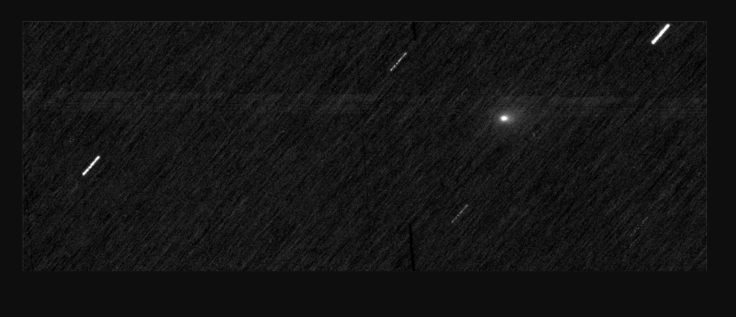3I/ATLAS Comet Visible Tonight — Astronomer Reveals How to See the Interstellar Visitor from Earth
See 3I/ATLAS tonight — NASA reveals when and where to spot the rare interstellar comet.

The night sky is set to deliver a celestial spectacle as the interstellar comet 3I/ATLAS becomes visible from Earth tonight. Astronomers are urging skywatchers not to miss this rare opportunity, with visibility conditions expected to be ideal across much of the Northern Hemisphere.
A Visitor from Beyond the Solar System
ALERT🚨:
— All day Astronomy (@forallcurious) November 5, 2025
Recently captured image of the Interstellar visitor, 3I/ATLAS!
Captured by R. Naves Observatory in Begur, Spain on November 5, 2025. pic.twitter.com/MNO2DNdjjZ
Comet 3I/ATLAS is no ordinary object drifting through the night sky. Detected after emerging from behind the Sun, the comet is believed to have originated beyond our solar system, making it only the second confirmed interstellar comet ever observed after 2I/Borisov in 2019. Scientists estimate that 3I/ATLAS may be older than Earth itself, roughly seven billion years, formed from the remnants of an ancient star system that predates our Sun.
Unlike most comets, which follow predictable elliptical orbits around the Sun, 3I/ATLAS moves at hyperbolic speed, confirming that it is merely passing through before vanishing into deep space once again. NASA's James Webb Space Telescope has been closely monitoring the object, studying its composition to uncover clues about the molecular building blocks that shaped early star systems.
Researchers believe the comet's composition, rich in frozen gases and interstellar dust, may offer vital insights into how water and organic materials were distributed across young planets billions of years ago. The comet's recent brightening, triggered as it neared the Sun and released volatile compounds, has made it visible to telescopes and even binoculars under clear skies.
How to See Comet 3I/ATLAS Tonight

Astronomers say the best time to view 3I/ATLAS will be just after sunset, when the sky darkens and the comet becomes distinguishable against the twilight. It will appear low on the western horizon, glowing faintly near the constellation Lyra. For those with access to dark, rural areas, the comet may even be visible to the naked eye, though binoculars or a small telescope will greatly enhance visibility.
NASA and other observatories recommend facing west and allowing your eyes at least 15 minutes to adjust to the darkness. The comet is expected to have a faint greenish hue due to the sublimation of diatomic carbon as sunlight interacts with its icy core. Viewers using a telescope may also spot a thin tail stretching away from the Sun, a result of solar radiation pushing dust particles outward.
Those unable to view the comet in person can tune in to several live broadcasts from global observatories offering real-time footage and guided commentary. The event is expected to last for several nights, but tonight's conditions are forecast to be the clearest.
Why 3I/ATLAS Matters for Science
The appearance of 3I/ATLAS offers more than just a visual treat. For astronomers, it represents a chance to study a fragment of the cosmos untouched since the dawn of planetary formation. Its composition could help scientists test long-held theories about interstellar travel, the transfer of cosmic material between star systems, and the origins of organic life.
The James Webb Space Telescope has already detected unique spectral signatures from the comet, suggesting it contains molecules rarely found in comets formed within our solar system. These findings support the idea that interstellar objects like 3I/ATLAS can act as time capsules, preserving the chemistry of ancient stars and nebulae that existed before our Sun was born.
As 3I/ATLAS continues its journey, scientists are racing to collect as much data as possible before it disappears from view for good. Once it exits the solar system, it may never return, travelling endlessly through the interstellar void, carrying the secrets of a universe long past.
A Rare Night for Stargazers
3I/ATLAS is a mystery interstellar object noted for its hyperbolic path toward the Sun and very high speed relative to the Solar System. In mere days, #3IATLAS promises to yield new information, and perhaps, new questions. I appeared on @NEWSMAX to discuss these developments. pic.twitter.com/LP7UQgTplA
— Dr. Michio Kaku (@michiokaku) October 26, 2025
For millions across the world, tonight's appearance of 3I/ATLAS is both a scientific milestone and a reminder of how vast and mysterious the universe remains. Whether viewed through a telescope, binoculars, or live streams online, this fleeting visitor offers a glimpse into the ancient forces that shaped existence itself.
As it drifts away from our skies in the coming days, 3I/ATLAS leaves behind not only a trail of cosmic dust but also a deeper sense of connection between humankind and the boundless cosmos beyond.
© Copyright IBTimes 2025. All rights reserved.





















